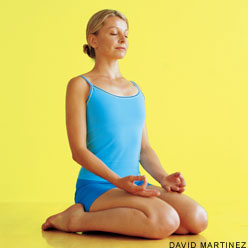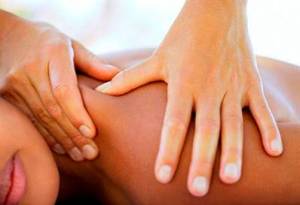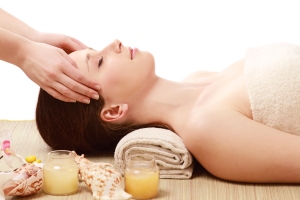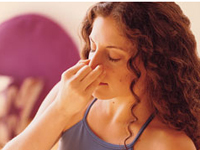 Humans have been known to survive for months without water and weeks without food yet die within minutes when deprived of oxygen. Respiration represents the power of prana, the ultimate expression of energy and life. When prana flows abundantly through our beings we become aware of a special glow to our skin and eyes, a spring to our step and the pulse of energy in every cell, vibrating vitality through every thought, word and deed. Conversely, an impeded or deficient flow of prana is marked by constant fatigue, dull skin and eyes and loss of enthusiasm. Breathing exercises are the easiest way to increase the flow of prana in our body and to unleash dormant prana.
Humans have been known to survive for months without water and weeks without food yet die within minutes when deprived of oxygen. Respiration represents the power of prana, the ultimate expression of energy and life. When prana flows abundantly through our beings we become aware of a special glow to our skin and eyes, a spring to our step and the pulse of energy in every cell, vibrating vitality through every thought, word and deed. Conversely, an impeded or deficient flow of prana is marked by constant fatigue, dull skin and eyes and loss of enthusiasm. Breathing exercises are the easiest way to increase the flow of prana in our body and to unleash dormant prana.
What is Prana?
”As the spokes are attached to the hub, so on this life breath, all is connected” – Ancient Indian treatise
In the ultimate sense prana is the subtlest form of all energies that permeate and sustain life in the cosmos. It is the underlying power supplying all universal forces allowing the ocean to surge, the sun to rise, flowers to bloom and the earth to revolve. The localized aspect of prana is the force uniting mind, body and spirit together known as the bio-energy field in humans. This flows from the spirit and is also absorbed from the atmosphere instantly through breathing oxygen and slowly through the colon with the transformation of food into energy.
Prana travels through our bodies via channels known as nadis, a concept similar to Chinese medicine’s chi, which travels along meridians. Absorbed through the medium of breath, prana has specifications on the respiratory, digestive, circulatory, cardiovascular, lymphatic and nervous system functions. Most importantly prana governs all the mental processes including thoughts, feelings, the will and reason. Longevity, health and vitality are all determined by the quality of prana flowing in our bodies. Taking in all this new information can be a bit overwhelming so now would be a good time to take a deep breath!
About Pranayama
“As wind drives away smoke and impurities from the atmosphere, pranayama is a divine fire which cleanses the organs, senses, mind, intellect and ego.” – BKS Iyengar
Pranayama is the art of breath control whereby the mental and physical state is brought to a harmonious state of health and serenity. It is a technique that increases, controls and frees the flow of prana throughout the entire body. The practice of pranayama brings awareness to the breath, which then connects us rapidly with our inner physical and emotional state.
Our relationship with life is mirrored in our breathing. When we’re nervous or excited our breathing becomes shallow, jerky and rapid. A relaxed, quiet state will create slow and deep breathing. Humans breath about 16-18 times a minute, inhaling about 13,000 litres of air every 24 hours. Due to exercise, anger, passion and anxiety the respiration rate increases, straining the heart and decreasing the life span. The slow, deep breathing and retention of breath in pranayama helps to compensate for the damage incurred by rapid, shallow breathing.
Pranayama also ensures a rhythmic harmony between the left bodily channel (ida) and the right bodily channel (pingala). This is important as these nadis govern opposite polarities in the body. Pingala which is stimulated by right nostril breathing promotes heat, masculinity, extroversion and digestion. Left nostril breathing stimulates ida which encourages cold, femininity, introspection and fertility. Roughly every hour our breathing shifts from one nostril to the other whereas pranayama encourages us to breath through both nostrils in order to maintain our bio-energetic balance.
Let’s Get Breathing!
For a beginner unfamiliar with pranayama please read the few guidelines below to help you set up for a healthy and sustainable pranayama practice.
The full Yogic Breath
- Lie down on your back, placing your right palm flat over your lower abdomen and your left palm at the top of your chest. The palms help to monitor the wave-like motion of the full yogic breath.
- Exhale, emptying the air from your abdomen and chest.
- Inhale deeply feeling your abdomen fill with air and rise then your chest up to the clavicle should fill with air and rise. Pause when you feel you have inhaled to your full capacity then inhale further.
- Exhaling the chest will first lower as the air is expelled then the abdomen will empty and contract.
- Continue this for 5 cycles. Once you have achieved a smooth rhythm proceed to pranayama exercises. The full yogic breath is to be observed whilst doing all pranayamas unless stated otherwise.
Ujjayi Pranayama (Baby’s Snore)
Best time for practice: Before meditation, before bed, and during yoga
Method:
1. Sit in a comfortable position with a straight back and neck.
2. Place your hands on the knees and close your eyes.
3. Exhale through the nostrils emptying your lungs and abdomen of air.
4. Slightly contract the throat and breath in deeply through the nostrils, keeping your mouth closed, for the count of 4. This will make a ‘sa’ sound similar to the gentle snore of a baby. The abdomen and chest should fill and rise.
5. Hold your breath at the top for the count of 2 then straighten head and exhale through the mouth to the count of 4. A ‘ha’ sound will be made on exhalation.
6. Repeat this cycle five times.Benefits:
1. Calms and focuses the mind.
2. Useful in respiratory tract disorders, hypertension, insomnia and fatigue.
3. Relieves nervous tension and anxiety
Guidelines for Pranayama
- The best time to practice pranayama is in the morning when the air is cool and the mind and body are fresh or at dusk.
- The bowels and bladder should be emptied.
- It is best to practice pranayama after exercises and before meditation.
- Find a secluded, quiet, clean, well-ventilated space, preferably free of insects.
- Sit in a comfortable position on the floor or in a chair with the back erect and the head straight. Vajrasana or sukhasana are good positions.
- A folded blanket, flat cushion or mat may be placed on the floor for comfort.
- Keep all your facial and bodily muscles relaxed.
- Close the eyes and rest the tops hands on knees.
- Breathe only through the nose unless stated otherwise.
This article was beautifully written from the folks at: Ayurveda Elements
Photos: Yoga Journal
 We’ve waited all year for this moment to arrive and finally summer has arrived! It’s the season of endless days, warm nights, laughter among friends, summer romance, beach days, boat trips, camping holidays and just good ol’ fashion summer play.
We’ve waited all year for this moment to arrive and finally summer has arrived! It’s the season of endless days, warm nights, laughter among friends, summer romance, beach days, boat trips, camping holidays and just good ol’ fashion summer play. “One must maintain a little bit of summer, even in the middle of winter.”
“One must maintain a little bit of summer, even in the middle of winter.”







